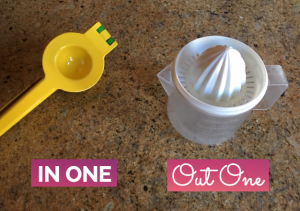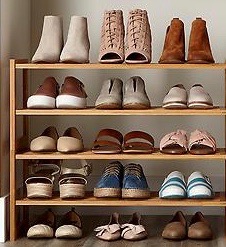If you’ve ever wondered, do organizers really practice what they preach?
I am here to say, YES! In my case, I follow 4 basic rules*:
1. Decide where things live
2. Return items to their “home”
3. Follow In One/Out One
4. Build routines around maintaining systems
 The third rule, In One/Out One, is the least appreciated and most neglected by our clients, even though it offers the best defense against clutter build-up.
The third rule, In One/Out One, is the least appreciated and most neglected by our clients, even though it offers the best defense against clutter build-up.
Here’s a personal story of how it recently went down in my house.
First you have to know that I LOVE citrus. Fresh lemon juice goes into every salad dressing. Fresh lime juice refreshes most fruit bowls. Many of my fish recipes require fresh lemon, lime or orange juice. So my juicer has been a staple in my kitchen. I love that it not only does a great job, it also attaches to a measuring cup – which makes it easy to know when I have enough.
Pictured below on the left, it had a primo spot in my most accessible gadget drawer just below my prep counter. Until…
 My husband, an aspiring minimalist, bought me a new juicer. He had researched to get me “the perfect gift.” I was skeptical, even though for him to buy something it MUST be great. I could not imagine HOW anything could replace my beloved juicer.
My husband, an aspiring minimalist, bought me a new juicer. He had researched to get me “the perfect gift.” I was skeptical, even though for him to buy something it MUST be great. I could not imagine HOW anything could replace my beloved juicer.
It would have to at least be:
• super easy to use
• simpler to clean
Well, my new citrus press is all that AND bold and bright. In being so colorful — I smile every time I see it.
 But it took me some time to let go of my trusted fave…2 weeks, in fact. I call it the testing time. Some “old” items deserve this reflective time.
But it took me some time to let go of my trusted fave…2 weeks, in fact. I call it the testing time. Some “old” items deserve this reflective time.
Honestly, it took me a week to open the package and try the new “citrus press.” I felt like I was cheating on my trusted go-to.
Once, I tried it, I set an alarm on my calendar to remind me to “consider if keeping new juicer” and a few days later “decide if still need old juicer.”
When you replace something, even if you are committed to In One Out One, you don’t HAVE to let go immediately. But you must put a time limit on making your decision. (It’s too easy for items to stagnate, clog your drawers and attract more clutter.)
Since I was using these gadgets daily, it didn’t take long to know I was in love. As for my “old” juicer, it still has life left in it. My son is a decent cook at college — so guess who just inherited a new fave? 🙂 When he graduates, I will gift him his very own citrus press!
* Remember I said these were 4 rules that I think every Professional Organizer follows?
It’s true of any organized person.
• You don’t have to be a professional organizer to be organized.
• Some people are MORE organized than their organizer (GASP!)
Yes…it’s true. Not every organizer is the MOST organized person you’ll ever meet.
• Professional Organizers know how to help YOU solve your organizational overwhelms and clutter-crisis.

I am a parent of two older teens, one in the first year of college and one in the later years of high school. As an organizer, my kids grew up with structure and routine, in hopes of them learning to be organized as adults. Our home was organized, our mornings ran fairly smoothly, and homework was completed without any issues. There were a few sticky points, such as screen time and bed time, but for the most part, our daily lives ran smoothly overall.
Now that they are older, the organizer mom in me still wants to help them be the most efficient they can be. But the cognitive side of my brain knows that now is the time to let go, and let them make their own decisions. I should only help them when they ask me for it. However, it is very difficult for me to sit back and watch them make mistakes such as scheduling two events for the same time, or running late for something. But I know the only way they will learn is by my stepping back and giving them the control to manage their own time, schedules, and things. They will make mistakes, and learn from them.
As hard as this is for me to let things go, I am getting better at it. I still sometimes find myself jumping in when I shouldn’t, and they both let me know when I am intervening where I shouldn’t be. I just take note of this, and try to not make that mistake again in the future.
I am sure I am not alone, being a parent during this transitional time. I wish all of you the inner strength and patience to step back, and let your teens develop into the wonderful young adults we all want them to be!
There are a lot of us who LOVE shoes. Why is that? Some shoes make us feel sexy or pretty while others feel like comfy slippers. They enhance our outfits and keep our feet safe. But when is “enough” more than enough?

WHO owns the most shoes? Statistics say the average man owns 11 pairs of shoes and the average woman 27 pairs. In my profession (and closet) I see more than that but 27 or under is a good goal to work toward.
WHY let go of shoes? To free your closet of congestion so you can see what you own and start to wear those previously hidden treasures. To make getting dressed less stressful. To save money because you won’t re-buy what you already own but can’t locate.
WHAT to let go of: The rule of thumb is to let go of shoes you haven’t worn in a year. The hardest to let go of are the attractive ones you love the looks of but that hurt. Or how about the ones you spent a lot of money on? There is no point in keeping shoes you won’t wear, even if letting go pulls at your heartstrings. Consider taking a photo of them but say good-bye. Let go of those old favorites that are too worn out to wear. Ask yourself: If I didn’t already own them would I buy them?
WHEN to purge: Get in the habit of reviewing your shoes (and clothes) twice a year when you’re switching out the seasons.
WHERE to dispose of unwanted shoes:
HOW to store: You’ll want to store similar types of shoes together (winter/summer and/or dressy/work/casual). You’ll want your shoes to be as visible as possible with what you wear most often to be most easy to access.
♪♫ Your shoes were made for walkin’ and that’s just what they’ll do♩♪
either by you or those in need!

We’ve all read books and articles about how to organize. I’ve even written many articles on what to do first, what to do second, etc. However, I’ve never written about what not to do. It seems counter-intuitive to write about anything negative, but sometimes we need to discuss this aspect about de-cluttering and organizing as well.
1. Don’t buy any organizing products until you see you what you actually need. You won’t know the answer to that until you finish de-cluttering and putting like with like to figure out the size of the product/container and where it’s going to go. Why waste your time buying something, not needing it, and then having to return it? You also have to remember where you put the receipt so you can return it and either exchange it for something that will work or just return it because you don’t need it.
2. Shop in your own home or office. Once you’ve finished de-cluttering and organizing, you will likely have something empty that will work to contain the items you have decided to keep. Think of the money you could save by using something you already own.
3. Stay in one area. Don’t jump from one space to another. If you do that, you’ll have spent hours all over your house or office and not get anything done. Let’s say you want to organize your living room and you find a hairbrush in that room. You take the hairbrush to the bathroom where it should live, and next, you start working on organizing your bathroom. Then, you find something that belongs in the bedroom, so you move to the bedroom. What’s the result? You’ve now been in 3 different rooms for the past several hours and haven’t gotten anything done in any of the areas. In this example, stay in the living room. If you see that something belongs in another room, put the item in a place near where that room is.
4. Don’t bite off more than you can chew. If you only have an hour, don’t tackle your 2-car garage. You may be able to work in a small area in the garage, but if you think you can get everything done in this small window of time, you may get discouraged and not want to continue when you have more time. Remember the SMART goals – specific, measurable, achievable, realistic, and timely.
5. Remove donated items and trash right away. You’ll be amazed at how you will feel and how much room you have when these items leave your home or office. It’s almost like a breath of fresh air. And, if you put them in your car to go somewhere, deliver as soon as possible so your car doesn’t become cluttered.

The answer is …. Sort of.
I don’t necessarily wear the EXACT SAME THING EVERY DAY, but yes, I have about 4-5 outfits that I wear ALL THE TIME.
Why do I do that?
As a business owner, mom and CFO and COO (and housekeeper and launderer …) of our household, I’ve got A LOT TO DO. So the last thing I want to waste my energy on is figuring out what the heck to wear.
So, my general formula is:
And that’s about it. There’s no magic formula. There’s no exact number of items. There are no rules.
Here’s a few things to try:
Pare it down
When you are at a stage in life where you’ve just got TOO MUCH TO DO, then DO LESS. Channel your inner Steve Jobs (black tee and jeans!), make one less decision, and kick your morning off right.
I saw every day as both an opportunity and an obligation to teach them about the world and life. From their first day home, I started talking to them about the beauty of nature, moral values and behavior, how to treat others, and why we lived the way we did.
Since I am wired to be the kind of person who becomes a professional organizer, I found life to be more messy and chaotic than I would have liked, and I had a sixth sense that it was only getting worse. And because I assumed my kids were wired at least somewhat like me, I knew they would one day benefit from knowing things like how to:
I wanted to teach them to enjoy and beautify the necessary activities of life instead of resenting them as an evil to be avoided until the last minute. Since education was a top priority, getting ready for school in an organized and happy way was part of that set of values.
And ending each year was a time for blissful relaxation: cleaning up together without hurry or deadline, purging and re-beautifying anything that was left in a mess. No matter what else might have been planned for the summer, down time to regroup and re-organize was also built in. No getting up and dressed in a rush. No obligations to any one or anything, just restful down time. We would snack and shop and play and bake at leisure. We would watch TV and clean up no-longer-needed schoolwork. We would update wardrobes and clean out drawers and closets.
Files would be created for any materials that might be needed the next school year. This was a time to take stock of materials and decide which products and systems worked well and might want to be repurchased in advance. We knew lists would be sent from school outlining what each teacher wanted for the next year, but we purchased whatever we could in advance to minimize time in the last-minute crowds. The girls and I did it all together in a spirit of leisurely family bonding and creativity. School, work, home-maintenance …these were all the ongoing art projects of living, enjoyed in an atmosphere of “eat dessert first.”
We always planned more private down time again before the beginning of school to gather focus and shop for remaining materials. We didn’t just race home from out-of-town the night before school, hoping someone would lend them a pen. We had been all but ready long ago!
There was nothing punitive about it; it was presented and experienced as a form of relaxation. To this day, when my daughters and I visit and want to relax at home together, we find something to improve. We joke that nothing tops a beautiful organizing product or system, or the joy of getting things done in advance.
Mission accomplished.
